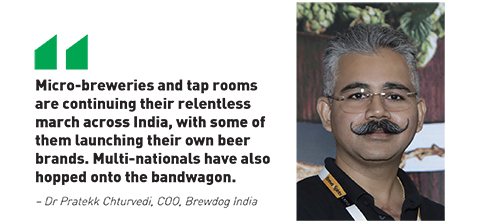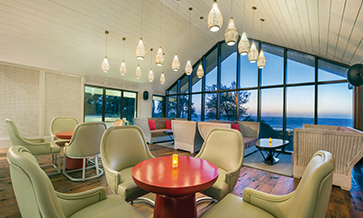Moderator
Dr Pratekk Chturvedi, COO, Brewdog India
Panelists
Narayan Manepally, Founder, Geist Brewing Co.
Jason Holway, Senior Consultant, The IWSR
Nitin Vishwas, Co-founder, Moonshine Meadery
Oliver Schauf, Brew Master, Doolally
Pratekk: Are we likely to see a renaissance in the packaged craft beer market, or will it be an international giant that will show us the way?
Narayan: Craft beer is in a nascent stage in India. We have got so much more to do, and the market is so very big. In 2021, Geist Brewing introduced crowlers for packaging our craft beer. But the further away a beer goes from your brewery the less control you have over its taste and shelf life.
It’s easy to do kegs, but when you start putting stuff into cans, things become infinitely more difficult. There is so much more of science and effort involved in canning, sealing, transporting and distributing canned craft beer that will retain its freshness and taste.
Pratekk: Geist, Toit and Effingut have grown from one location into multiple states. Among the Big Boys, AB InBev has come up with ‘Seven Rivers’. Oliver, what are your views on what’s happening now?
Oliver: Doolally, the first micro-brewery in India, started 15 years ago. Now we have 80-odd brewpubs in Bengaluru, more than 20 in Gurugram, and many more sprouting all over India. However, in the beginning, the beer quality didn’t always keep up and was sometimes questionable.
I think it’s doubtless that craft beer as a restaurant concept has come a long way on an incredible journey. There are still many challenges ahead of us: taxation, the retail system and local supply chain. All this is starting to change, but I see this is going very slowly.
Pratekk: Nitin, you are doing some great stuff in the meads market. How are things looking up for you guys?
Nitin: Products from Moonshine Meadery are available four states and three countries at the moment. There’s a lot of room in India for flavourful beverages – mainly because the range of Indian cuisines is so varied and rich.
I see more people, as they enter the legal drinking age, not wanting to be caught dead imbibing what their fathers and mothers, grandfathers and grandmothers drank. They want to drink something different, something more young, flavourful and contemporary.
We’re now also tapping into the nostalgia element. The whole idea is to go deep down into your consumers’ subconscious and tickle that little nostalgia-act memory with a beverage that is made well. That is how Moonshine Meadery came out with its mango-chili, guava-chili, salted kokum and apple cider variants.
Pratekk: Jason, coming from IWSR, you probably have a lot of information for us which is data-based….
Jason: I think that a lot of you need to put this in context. And the context is that India is a strong beer market. Budweiser’s got an 8% share in this market – which is unusual. I don’t think there’s too much of a problem with being local, being regional, being Indian. There are all those micro-breweries and counting!
At the same time, if you want to grow your product, you need to have the consistency – I don’t say quality because quality is pretty much always there. In India what I see of craft is very much the cream on top, it’s a small part of the market. The majority of the market is strong beer in 600-ml bottles, consumed outside the shop because of lack of refrigeration.
Pratekk: Narayan, do you think no-alcohol beer could become a thing? What’s your experience when you play with multiple grains for your beers?
Narayan: Truthfully in our business we don’t focus on no-alcohol beer because, even according to our customers, it will take a long-long time to happen. A lot of people are doing it because it’s surrogate advertising. I think that only for more mature markets low- or no-alcoholic beers become relevant. One of our fastest-selling beers, James Blond at 7.7% ABV, is a ‘paisa vasool’ proposition.
The concept of millets is interesting and we have done some experiments where we’ve used maybe 40% millets. The size of the grain is really small, so you need different ways of lautering the mash. Craft breweries don’t have mash filters so you’ll need a rethink on the process.
The other problem is Geist is a commercial brewery – we produce six times the beer of a traditional micro-brewery. To interrupt that production to do a small batch beer is hard for us. Right now I’d rather focus on my bread and butter!
Pratekk: I now come to our favourite whipping boy: alcohol policy! Micro-breweries in Delhi and Punjab are allowed kegging, but neighbouring Haryana and Chandigarh are not. Rajasthan will not let you take beer in; Karnataka will not let you take beer out. Nitin, you said you are in four states; what has your experience been?
Nitin: To begin, there was no category called ‘mead’. We had to explain it to the government; talk to them about honey; connect it to the agricultural story; tell them how it benefits farmers. We had to explain what the policies in the West look like, what the policies in the East look like, and then sort of try and squeeze mead in.
Maharashtra finally classified mead under the broader umbrella of wine. So we can go from state to state and the costs are not that high; because at least till now the understanding was that Karnataka and Maharashtra will remain the only states producing wine.
Now we see Uttar Pradesh has created a mead-wine policy, Rajasthan created one, because these states are leading in honey production and they suddenly realize they can create their own intrinsic wine policies. I think we are now staring at a future where wine policies are also going to be as complicated as those for beer and spirits!
Pratekk: Although state policies on liquor can be quite rigid and complicated, we did end up bumping into officers who were helpful. I remember meeting the excise deputy commissioner of one state and telling him he had been way nicer to us than we expected. He responded saying you guys are an educated bunch of people – if you are coming here and asking for help, why not? So it is a mixed bag I guess, there are states, there are officers where we end up hitting a wall; and there are others where the system seems to help us find a way and take things forward.
For the full report, visit the Youtube channel of B&S Expo.













